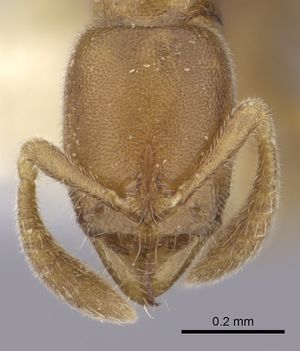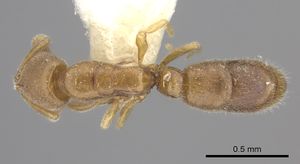Ponera petila
| Ponera petila | |
|---|---|

| |
| Scientific classification | |
| Kingdom: | Animalia |
| Phylum: | Arthropoda |
| Class: | Insecta |
| Order: | Hymenoptera |
| Family: | Formicidae |
| Subfamily: | Ponerinae |
| Tribe: | Ponerini |
| Genus: | Ponera |
| Species: | P. petila |
| Binomial name | |
| Ponera petila Wilson, 1957 | |
| Synonyms | |
| |
The single worker (holotype) was collected as a stray in the superficial layers of soil beneath a rotting log on the ground in primary lowland rainforest.
Identification
Taylor (1967) - The species group characters (4-segmented antennal club, absence of an incised mesmetanotal suture), and the small size, allow preliminary diagnosis. Petila may be separated from Ponera szaboi and Ponera szentivanyi by the following characters: From the probably sympatric szaboi, by slightly larger size (HW 0.32 mm, DPW 0.18 mm, opposed to 0.30-0.31 mm, and 0.15 mm respectively in szaboi). Proportionately longer scapes (SI 88; in szaboi 78-83), and broader petiolar node (PNI 72 against 65 in szaboi). Sculpturation of petila is considerably less intense than that of szaboi (compare the description below and for szaboi).
2. From szentivanyi, by smaller size (HW 0.34 mm in szentivanyi), broader head (CI 78, opposed to 75 in szentivanyi), and other dimensional differences (e.g., SI 88 in petila, 94 in szentivanyi, etc.). Sculpturation of the head and mesosoma of szentivanyi is about intermediate between that described for petila and that of szaboi discussed below.
Csősz et al. (2023) - Small species, absolute cephalic size (CS): 386 μm [372, 393]. Body color yellow to light brown. Body concolorous.
In the Malagasy region, P. petila can only be confused with Ponera swezeyi (relevant diagnostic characters are discussed under P. swezeyi). Worldwide, P. petila workers differ in size from all other species but Ponera szentivanyi. The latter species is reported to have a wider head (CWb: 340 µm, see Wilson, 1957) than P. petila (CWb: 333 µm [323, 339]), but the scape index (SI) of the P. szentivanyi is considerably larger (SI: 94) than that of P. petila (SI: 85 [82, 88]).
Keys including this Species
Distribution
Latitudinal Distribution Pattern
Latitudinal Range: -5.333° to -6.75°.
| North Temperate |
North Subtropical |
Tropical | South Subtropical |
South Temperate |
- Source: AntMaps
Distribution based on Regional Taxon Lists
Indo-Australian Region: French Polynesia (type locality), New Guinea (type locality).
Malagasy Region: Mauritius, Seychelles.
Distribution based on AntMaps
Distribution based on AntWeb specimens
Check data from AntWeb
Countries Occupied
| Number of countries occupied by this species based on AntWiki Regional Taxon Lists. In general, fewer countries occupied indicates a narrower range, while more countries indicates a more widespread species. |

|
Estimated Abundance
| Relative abundance based on number of AntMaps records per species (this species within the purple bar). Fewer records (to the left) indicates a less abundant/encountered species while more records (to the right) indicates more abundant/encountered species. |

|
Biology
|
Castes
Images from AntWeb
   
| |
| Specimen code casent0060356. . | |
     
| |
| Male (alate). Specimen code casent0136714. Photographer Erin Prado, uploaded by California Academy of Sciences. | Owned by CAS, San Francisco, CA, USA. |
   
| |
| Holotype of Ponera petila. Worker. Specimen code mcz-ent00030124. Photographer Michele Esposito, uploaded by California Academy of Sciences. | Owned by MCZ, Cambridge, MA, USA. |
  
| |
| Worker. Specimen code CASENT0249220. Photographer Will Ericson, uploaded by California Academy of Sciences. | Owned by Philip S. Ward Collection. |
Phylogeny
| Ponera |
| ||||||||||||||||||||||||||||||||||||||||||||||||||||||||||||
Relationships among selected species of Ponera based on Branstetter & Longino (2019). The focus of this study was the species Ponera exotica and Ponera pennsylvanica.
Nomenclature
The following information is derived from Barry Bolton's Online Catalogue of the Ants of the World.
- petila. Ponera petila Wilson, 1957b: 368, fig. 2 (w.) NEW GUINEA.
- See also: Taylor, 1967a: 102.
- bableti. Ponera bableti Perrault, 1993: 334 (w.) FRENCH POLYNESIA (Mururoa I.).
- Junior synonym of petila: Csősz et al., 2023: 8.
Type Material
Ponera petila
- Holotype worker, lower Busu River, Huon Pen. N.G., [lower rainforest,], V-/0-55 #999, E.O. Wilson, (Museum of Comparative Zoology, MCZ-ENT00030124) [examined by Csősz et al., 2023].
Ponera bableti
- Holotype and paratypes: Fangataufa, “mers” 1987 “unintelligible text”, Ponera bableti Perrault (1993) det T. Ramage, (6w, Musee National d'Histoire Naturelle, holotype: EY25377, paratypes EY25378, EY25379, EY25327, EY25328, EY25329) [Examined, measured by Quentin Rome based on the same character recording protocol defined in this paper, MNHN] (Csősz et al., 2023).
Description
Worker
Holotype. HW 0.32 mm, HL 0.41 mm, SL 0.28 mm, CI 78, SI 88, PW 0.25 mm, petiolar height 0.25 mm, petiolar node length 0.13 mm, dorsal petiole width 0.18 mm. Very similar to Ponera szentivanyi, differing slightly in body and appendage proportions as given in the measurements cited above, and in the much feebler body sculpturing, which can be described as follows. Sides of head densely but shallowly punctate, and feebly shining. Entire dorsal and lateral surfaces of the alitrunk with puncturation or shagreening of variable density but everywhere shallow and feeble, so that the surface is feebly to strongly shining. The gastric tergites are also more feebly sculptured than in szentivanyi and their surfaces overall feebly shining.
Taylor (1967) - Wilson’s description did not mention lack of an incised mesometanotal suture in the workers, or that the palpal formula appears to be Maxillary 2: Labial 2 (the mouthparts are only partially exposed; so a positive count is impossible).
Sculptural details required for diagnosis are: head moderately shining, with small point punctures separated by distances about equal to their maximum diameter. Pronotal dorsum fairly strongly shining, with scattered minute punctures; mesonotum almost imperceptibly more closely punctate. Lateral surfaces of mesosoma feebly shagreened to smooth and shining.
Wilson’s dimensions of the holotype are: HW 0.32 mm; HL 0.41 mm; SL 0.28 mm; CI 78; SI 88; PW 0.25 mm; PNL 0.13 mm; PH 0.25 mm; DPW 0.18 mm; PNU 72.
Csősz & Fisher (2023) - Small species, absolute cephalic size (CS): 386 μm [372, 393]. Body color yellow to light brown. Body concolorous. Head Small.
Head Small, Head width (CWb): 333 μm [323, 339]; and conspicuously longer than broad, Cephalic index (CI):76 [74, 77]. Frontal lobe distance vs. absolute cephalic size (FRS/CS): 0.22 [0.20, 0.24]. Head dorsum coarsely punctate. Anterior clypeal margin lacks a median indentation or notch. Eyes absent, occasionally 1 to 3 facets are visible. Scape short, Scape index (SI): 85 [82, 88]; when laid straight back from its insertion the apex falls far short of the midpoint of the posterior margin in full-face view. Mandibles with 3 distinct apical teeth occupying half of the masticatory border.
Mesosoma Pronotal-mesonotal articulation present and moderately developed across dorsum of mesosoma; sometimes a weakly defined shallow groove visibly interrupts the surface. Metanotal groove inconspicuous, rarely absent. Dorsal surface of mesosoma punctate, slightly shiny. Lateral surface of pronotum finely punctate, ventral area smooth and shiny. Mesopleural sculpture inconspicuous, medial and ventral part smooth and shiny; metapleural sculpture inconspicuously punctate, centrally smooth and shiny.
Petiole Petiolar node not squamiform, moderately large; petiole width vs. absolute cephalic size (PEW/CS): 0.50 [0.48, 0.53]; broader than long, (PEW/PEL): 1.35 [1.28, 1.45]; anterior face of node bluntly rounded, the sides usually slightly divergent posteriorly. Petiole node in profile moderately low and long, with a relatively short and weakly convex dorsum. Dorsal region of petiole smooth to finely punctate, shiny. Anterior and posterior faces of node usually weakly convergent dorsally, sometimes nearly parallel. Lateral surface of node meets the posterior surface in rounded transition without cuticular ridge or transverse carina. Subpetiolar process developed, its apex forms a right angle (rarely acute angle).
References
- Csősz, S., Loss, A. C., Fisher, B. L. 2023. Exploring the diversity of the Malagasy Ponera (Hymenoptera: Formicidae) fauna via integrative taxonomy. Organisms Diversity & Evolution (doi:10.1007/s13127-023-00610-1).
- Taylor, R. W. 1967a. A monographic revision of the ant genus Ponera Latreille (Hymenoptera: Formicidae). Pac. Insects Monogr. 13: 1-112 (page 102, see also)
- Wilson, E. O. 1957b. The tenuis and selenophora groups of the ant genus Ponera (Hymenoptera: Formicidae). Bulletin of the Museum of Comparative Zoology 116: 355-386 (page 368, fig. 2 worker described)
References based on Global Ant Biodiversity Informatics
- Janda M., G. D. Alpert, M. L. Borowiec, E. P. Economo, P. Klimes, E. Sarnat, and S. O. Shattuck. 2011. Cheklist of ants described and recorded from New Guinea and associated islands. Available on http://www.newguineants.org/. Accessed on 24th Feb. 2011.
- Taylor R. W. 1967. A monographic revision of the ant genus Ponera Latreille (Hymenoptera: Formicidae). Pacific Insects Monograph 13: 1-112.
- Wilson E. O. 1957. The tenuis and selenophora groups of the ant genus Ponera (Hymenoptera: Formicidae). Bulletin of the Museum of Comparative Zoology 116: 355-386.
- Wilson E. O. 1958. Studies on the ant fauna of Melanesia III. Rhytidoponera in western Melanesia and the Moluccas. IV. The tribe Ponerini. Bulletin of the Museum of Comparative Zoology 119: 303-371.
- Wilson Edward O. 1959. Adaptive Shift and Dispersal in a Tropical Ant Fauna. Evolution 13(1): 122-144


